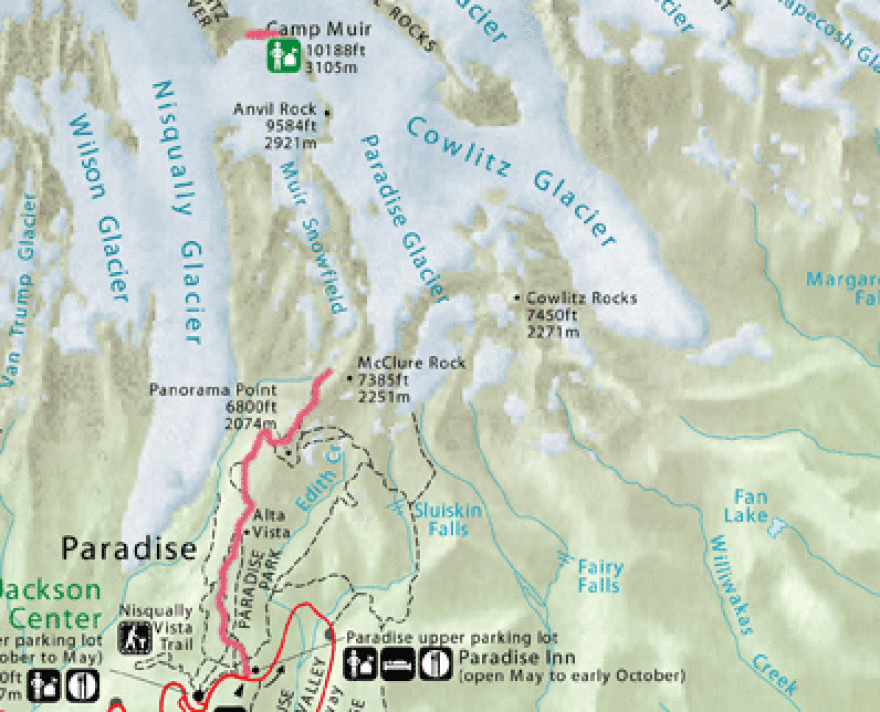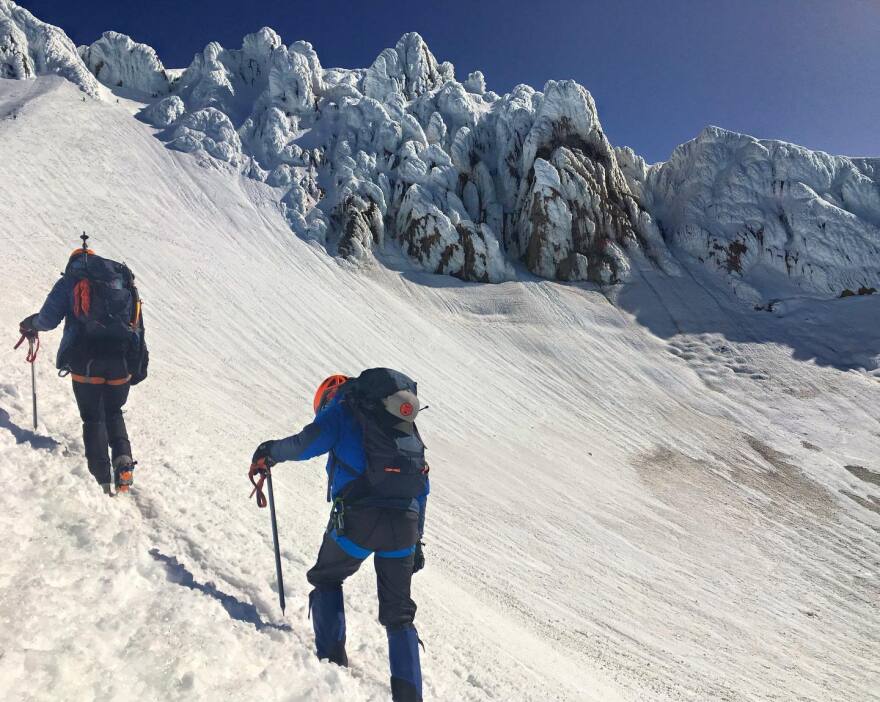
Listen
For many outdoor recreation guides, the past few months stuck at home have been different than any other spring in recent memory.
“We make a joke that the mountains are closed, which just seems odd to say,” Mick Pearson says.
Pearson runs Kaf Adventures, an outdoor education and adventure travel company based in Seattle. He’s used to guiding small groups, from one to nine people. Pearson has led people across mountain ranges, up climbing crags in the central Cascades or to the summit of Mount Baker.
“Even when someone is just learning a new skill, it feels so good to help people in the process of becoming better at what they want to do,” Pearson says. “That human connection is what fuels me. Each one of those trips has some of that element, and I think that’s what I’ve been missing.”
Instead, this spring he’s been navigating payment protection program loans, COVID-19 policies and customer communication.
It’s been a rough couple of months for outdoor recreation businesses – from mountaineering and rock climbing guides to river rafting, sea kayaking, mountain biking guides and private campgrounds. Outdoor recreation brings in big bucks to the Northwest — especially to many of the rural communities that act as gateways to the great outdoors.
Consumer Spending
According to the Outdoor Industry Association, the recreation economy generates $7.6 billion in wages and salaries and $26.2 billion in consumer spending in Washington. In Oregon, that looks like $5.1 billion in wages and salaries, $16.4 billion in consumer spending. For Idaho, it generates $2.3 billion in wages and salaries and $7.8 billion in consumer spending.
As of April 2020, the leisure and tourism industry suffered some of the highest unemployment rates across the Northwest.

A Kaf Adventures guided trip up Oregon’s Mount Hood. Courtesy of Kaf Adventures via Facebook
In a letter to Gov. Jay Inslee, the Washington Outdoor Business Alliance stated that tour bookings are down 50 to 90%, year to date. It said outfitters are often losing money because they are refunding many pre-booked reservations.
That could be detrimental to outdoor businesses, which are losing core parts of their seasons – some of which only operate through October, the letter said. Then it’s more difficult to make up the lost revenue.
“We have a transient kind of career, in that we have to follow the seasons, especially living in Washington,” Pearson said.
Kaf Adventures was closed for seven weeks, during an often busy time of year for guiding services. It’s slowly starting to open up. The first week in June guides led a few trips up Oregon’s Mount Hood.
The small business loan has ensured Pearson could keep his roster of guides employed. But even in “normal” years, money can be stretched thin, he says.
“We think we can manage it, and we’re hopeful. But I’ll be honest. We have about a month left, and if things don’t change, and the PPP money runs out, we’ll be in a tough place. Probably I would have to close my doors by the end of July,” Pearson says.
That’s a concern for a lot of outdoor recreation businesses across the Northwest. Randy Rosenberger, who teaches applied economics at Oregon State University, said outdoor recreation brings money into small communities from tourists – that’s people coming from at least 50 miles away.
“It’s critically important to these communities,” Rosenberger says.
Those tourism dollars are different from the money locals spend heading to a trailhead. It’s money that communities didn’t have before – and it stretches beyond guides and parking fees, Rosenberger said. There’s gasoline, hotel stays, dinners out, any last-minute supplies.
Rosenberger says this economic downturn has combined parallels with other past recessions. Think the fear after 9-11 (now, the fear of large crowds), plus the market collapse of 2008 (now, many more people have lost jobs and disposable income). Now, add travel restrictions.
“This impact on recreation and tourism is huge. I don’t think we’ve ever seen anything quite like it before,” Rosenberger says.
Off The Rainier Summit — For Now
Restrictions might keep mountaineer hopeful Andrea Frye off the summit of Mount Rainier this year. For the past five years, she’d planned to watch the sunrise from the summit on her 40th birthday.
Frye grew up in Graham, Washington, in the foothills of Mount Rainier and now lives near Spokane. She watched her dad summit the state’s tallest peak when she was three and always dreamed of seeing the views for herself.
“That’s home to me, the mountain is. I’m just really drawn to it,” Frye says. “I think in this time of chaos in the world, I’d really been looking forward to not only just standing on the summit for my birthday and sharing the experience with my husband. That just really is peace and calmness for me.”
The dream was for her and her husband to make the trip with another couple. The group hired a private guide, who recently told her climbing passes aren’t being issued above 10,500-feet. They would only be able to make it to Camp Muir, and that’s if other parts of the national park also reopened in time.

At 10,188 feet, Camp Muir on the south side of Mount Rainier is base camp for many summit expeditions beginning from the Paradise area of the national park. CREDIT: National Park Service
But, she said, her guide is going to keep an eye on the constantly evolving situation. He also recommended other trips that may open sooner, climbs up Mount Adams, Mount Hood or Mount Baker.
“I might not be able to climb for my birthday, but hopefully by late season, end of August, we’ll be able to climb ( Rainier). That’s still all up in the air,” she says.
When Frye first realized she’d miss the climb, the thought stung. But a few minutes later, she realized she had a lot going right.
“Really, if that’s the biggest concern and the biggest way I’m being impacted by COVID-19, that’s pretty silly to be disappointed,” Fyre says.
Running The River, Skiing Spring Runs
Many guiding groups hope to reopen soon and begin rescheduling customers. Whitewater rafting company Blue Sky Outfitters, which guides tours on the Wenatchee River, said the company has been closed for three months and hopes to open as soon as the state and Chelan County give the go-ahead.
Ski resorts across the state closed down just as spring skiing was kicking off. Sea kayaking companies had to refund tour dates.
But not all outdoor activities have ground to a halt. Economics professor Randy Rosenberger says bicycle sales have been “through the roof,” as people begin to explore closer to home. The problem is, that doesn’t bring in outside money or tourism spending as people ride around their towns.
“If people decide to do more recreation locally, maybe they’ll buy more standup paddleboards, kayaks and get out on the waterways. There’s a lot of stuff people will start switching into,” Rosenberger says.
Eventually, maybe people won’t want to fly, but they’ll be comfortable traveling in an RV. That could help campgrounds and RV sales, he says.
Leaner Years And Managing Risks
It’s not just small outdoor recreation businesses that have been hit hard. Large guide services are trying to figure out how to survive a very lean year.
Jason Martin is executive director of the American Alpine Institute, which runs outdoor climbing and education programs in six states and 16 countries. Martin said about one-third of the trips his company organizes are in Washington.

Reporter Courtney Flatt climbs on a guided trip at Smith Rock State Park in Central Oregon, one of the most popular and expansive rock climbing spots in the Northwest. CREDIT: Sara Schilling
In a normal year, AAI would be lining up trips in the Cascades right now. The company entirely missed the spring seasons in places like Red Rock Canyon, outside Las Vegas, and Denali in Alaska.
As the company starts running trips again – Martin hopes that begins June 20 – the services will be different. Guides will lead fewer climbers on every trip. Instead of riding in vans, people will drive themselves to trailheads.
Many customers have understandably canceled, Martin said. It all makes for a leaner few years ahead.
“Looking ahead in 2021, we expect we’ll be able to operate (in places like Denali),” Martin says. “But it’s going to take awhile (to get back to normal) because all the people who wanted to go in 2020 have rescheduled to 2021. The new income from next year is going to be limited.”
AAI received loans, but it also had to lay off staff. Martin says they’re bringing back employees now, as the summer season resumes.
The company built a 25-page COVID risk management plan. There are instructions on how far apart people can walk on trails without wearing a mask. (It’s often hard to climb uphill with a heavy pack, while wearing a mask, Martin said.) Even the much-sought-after summit photos will have to scale back.
“Most commonly everybody gets to the summit, and they hold their ice axes up in the air, but now it’s going to be (different),” Martin says. “Obviously couples can drape their arms over one another, but a lot of our programs are individuals. So we’ll separate them and just do one shot at a time.”
Camping is another challenge. Tents will be spaced far apart – and in certain backcountry areas it may mean people are camping 50 feet apart to meet distance requirements and to protect land that’s not meant to be a campground.
(Other groups, like Kaf Adventures, might experiment with tarps or sleeping under the stars. Mick Pearson said they’re still considering the options.)
“It may not always be the most fun. People come to these programs, and they meet new people. It’s got a summer camp feel to it,” Martin says. “Instead, (people may) not have that bonding experience in the same way. That’s one of my biggest fears. … We’re afraid this might be the ‘new normal.’ We’re expecting that we may be doing this for the next couple years.”
That’s all a part of managing risks – something the great outdoors teaches people every day, Martin says. Think about avalanche risk assessment.
You can’t always see when there’s a possibility of avalanches, but you should still wear avalanche transceivers, balloon packs and carry probes, just in case. Then assess the terrain as you go.
Martin says the pandemic is a lot like that: Just because you might not see people getting sick all the time doesn’t mean it won’t happen. Now, they’ll wear masks, carry hand sanitizer and wash hands.
“Even though we can’t see the risk, we know it’s there, so we’re going to treat it the same way,” Martin says. “I think that mountain guides – because we are constantly assessing risks … we have to look at this the same way. I think we’re uniquely suited to do so.”
Related Stories:

Copyright 2020 Northwest Public Broadcasting
